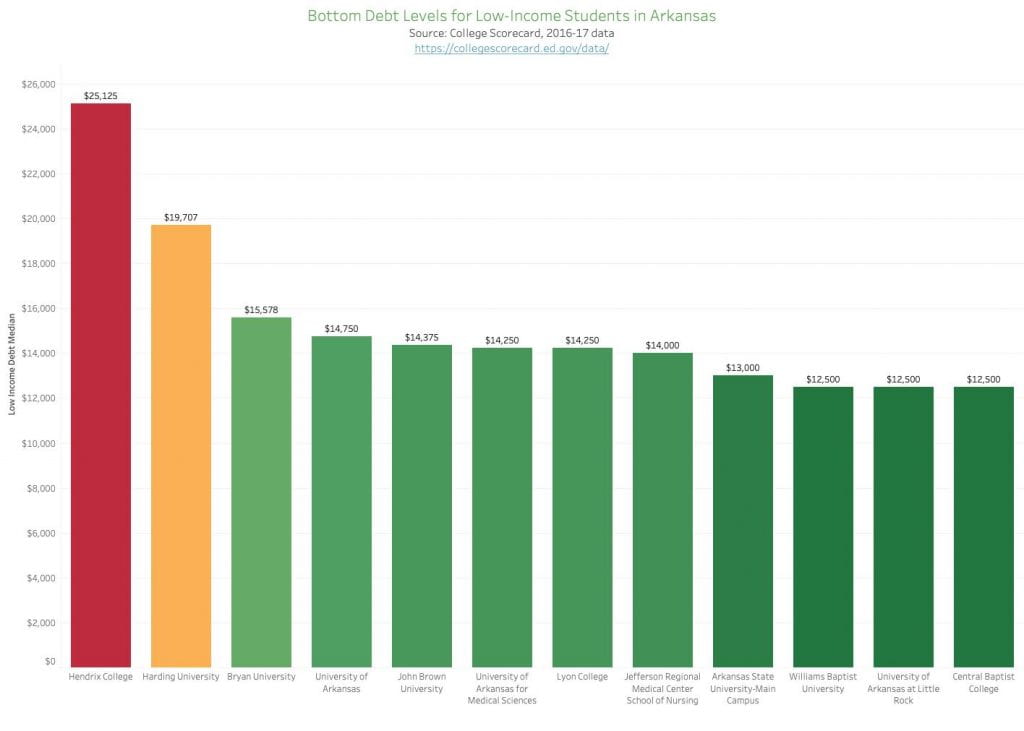Low & High Income Students Choose UofA Over Community College
Some community college students transfer to the UofA despite prospects of heavier student debt.
By Hanna Ellington, Sophie Neubaum, and Kate Duby
Many students across Northwest Arkansas transfer from community colleges to four-year institutions despite higher tuition costs and student debt. The UofA ranks fourth highest in low-income student debt rates across the state, according to College Scorecard data from the 2016-17 academic year.
For many students, getting an undergraduate degree from a four-year institution comes at the cost of taking out student loans. For low-income students, debt from the UofA is almost $15,000, according to College Scorecard. On the opposite end, NWACC results in just over $6,000 in debt for low-income students.

The UofA is working to reduce the financial strain by having transfer students work with advisors before transferring schools, said Denise Burford, the associate director of financial aid.
“Our academic advisors are really good at helping them understand what classes they could continue to take there to save costs before transferring here,” Burford said. “We’ve got a solid transfer advising program between the two schools, so a student can take as many classes as they can there and not have to take some here.”
Although the UofA takes preventative action to reduce the cost of transferring, it is likely that students who transfer will use other resources to lower costs, Burford said.
“I would say most of the students that transfer from NWACC to here are going to be applying for federal financial aid,” Burford said.
The undergraduate debt disparity among low-income and high-income UA students ranks 27th in the state, according to College Scorecard. Average in-state tuition for the UofA is approximately $7,500, according to UofA financial aid website. In comparison, in-district tuition for NWACC is approximately $1,800, according to NWACC’s financial aid website.
In May, the UofA announced they would be offering a scholarship for students who graduate with an associate’s degree from a two-year institutions in the UA system. The scholarship will reduce the UA tuition rate to the same rate the student paid at the two-year institution, Chancellor Joe Steinmetz said at the commencement of UA Rich Mountain.
Melissa Moznabi, 19, a sophomore from Rogers, will accumulate approximately $10,000 in student debt by the time she graduates from the UofA. Her tuition cost will amount to roughly $2,000 per semester.

Moznabi, who is majoring in theater, chose to attend the UofA because the school offered her intended degree plan. Moznabi considered attending community college, “but ultimately it didn’t have what I wanted in higher education,” she said.
Savannah Fields, 20, a UofA sophomore from Fayetteville, began her college career at Northwest Arkansas Community College because of the reduced cost. She said she expects to accumulate over $20,000 in student debt, even with in-state tuition and scholarships.
“I went to NWACC because it’s obviously a lot cheaper, and I also wanted to focus on my classes and not get overwhelmed with the college experience,” Fields said.
While Fields said she understands that transferring is costly, she thinks the extra expense is worth it. She said she thinks the extracurricular opportunities, peer collaboration and freedom go hand-in-hand with her education and will benefit her career.

NWACC freshman Felicity Hunt, 18, of Farmington chose to further her education at community college after graduating from Farmington High School.
Hunt thinks NWACC and other community colleges, are good options for students who want to give themselves more time to understand what careers they wish to pursue, she said.
“Honestly, I didn’t really know what I wanted to do, so I didn’t want to commit to going to a four-year without fully understanding what I wanted to pursue a degree in,” Hunt said.